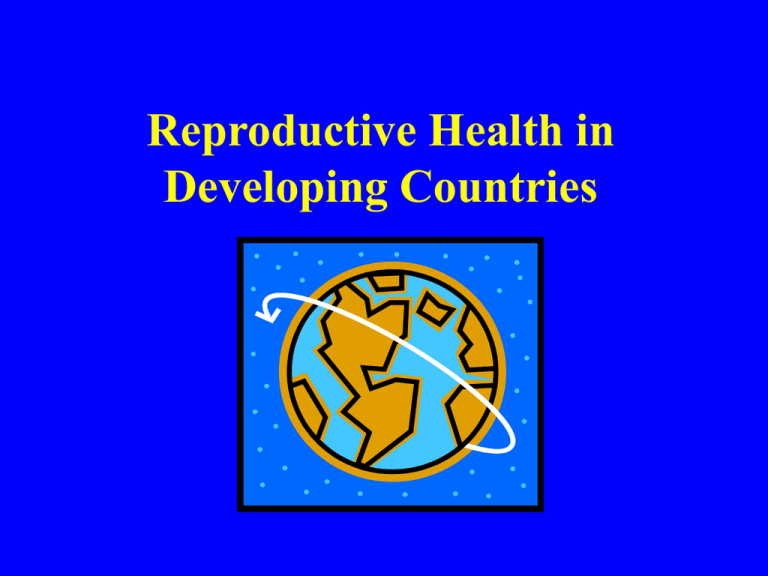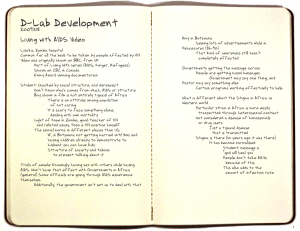
Reproductive Health in
Developing Countries
Adolescents: taken more
seriously?
• UN General Assembly Special Sessions:
– Drugs (1998)
– HIV/AIDS (2001)
– Children (2002)
Demographic Health
Surveys (DHS)
More adolescents than anytime
in recorded history
• 1.2 billion 10-19
• 1.7 billion 10-24
• 20-25% of world’s population
• 86% in developing countries
Sexual activity and outcomes
vary by region
•71% U.S. females/81% males sexually experienced by age 20
•Puberty earlier, marriage later, premarital sex more common
•pregnancy rates declining in many countries
•33% give birth <20 in developing countries (20% U.S.)
•highest rates of STIs= 15-24 year olds
Trends in Pregnancy, Birth and Abortion Rates per 1,000
Females 15-19, USA
140
120
117
111
91
86
51
49
27
25
80
60
60
54
40
41
42
60
48
37
20
Abortions
Births
Pregnancies
45
02
20
01
20
00
20
99
19
97
19
93
19
90
19
89
19
86
19
83
19
80
0
19
Rates per 1000
100
110
43
100%
100%
90%
85%
82%
81%
80%
70%
69%
65% 68%
62%
65%
60%
50%
55%
42%
23%
% pop 10-19
40% 39%
36%
40%
30% 23%
62%
24%
22%
22%
41%
33%
24%
34%
28%
26%
22%
22%
20%
22%
20%
20%
14%
10%
U.
S.
Pe
ru
Eg
yp
t
Tu
nis
ia
Ba
ng
la d
es
h
Ph
i lip
pin
es
Th
ail
an
d
Me
xi c
o
0%
Ta
nz
an
ia
Zi m
ba
bw
e
Na
mi
bi a
% women 15-19 >7 yrs
school
36%
% 20-24 who gave birth
by age 20
HIV/AIDS
•
•
•
•
•
•
•
12 million 15-24 living with HIV/AIDS
6,000 infected daily
Account for >1/2 new infections
62% female
>20% in many sub-Saharan
rates 2nd highest in Caribbean
Why:
–
–
–
–
–
Info?
Skills?
Societal norms & practices?
Access to youth friendly services?
Policies?
% of Non-voluntary (forced) and Unwanted Sex, by
age, United States
80%
70%
60%
50%
40%
30%
20%
10%
0%
< 13
13-14
15-16
Age at First Sex
Non-voluntary
Unwanted
17-18
Sexual abuse & violence in SubSaharan Africa
• estimating prevalence difficult
• regular physical abuse of young women:
Uganda (46%), Tanzania (60%), Kenya
(42%), Zambia (40%)
• ½ of sexual assaults against girls <15
• boys also (15% Ugandan boys)
• effects on women & children who witness
• social stigma prevents speaking out
Barriers to RH care
•
•
•
•
•
•
•
Lack info (e.g. not at risk, myths, unaware)
Stigma (males & females)
Provider attitudes & skills
Concerns about confidentiality
Logistics
Policies
Social/cultural barriers (seek permission)
What are “Youth Friendly” RH Services?
•
•
•
•
•
•
•
•
•
Visible
Clinical/program environment
Staff attitudes (training, supervision, monitoring)
Convenient hours/location
Affordable
Full range of RH care
Policies & procedures (protocols, guidelines)
Youth involved @ all stages
Sensitive to gender norms
10-24 year olds use of RH care after intro youth
friendly services, Lusaka, Zambia
1600
1400
1200
1000
800
600
400
200
0
1,380
1,018
836
650
368
468
430
207
new FP users
revivit FP
STI services
prenatal
1998
1999
Beyond Clinics
•
•
•
•
•
•
Pharmacies
Kiosks
Retail stores
Youth Centers
School/Clinic links
Mass media/theatre
Public Health Advocacy?
An effort to change public
perceptions about an issue and
influence policy decisions and
funding priorities
Takes many forms
Strategic Steps
•
•
•
•
•
•
•
•
Needs assessment
Goals & objectives
Collaborations
Involve youth
Educate public (media)
Persuade policy makers
Anticipate/respond to opposition
Evaluate results & adjust
Needs Assessment
• Assess health status of target youth in
specific community
• Gather info on availability & utilization
of services, including gaps & barriers
• Assess local, national, regional,
institutional policies that affect
availability & utilization
I. Assess Needs
•
•
•
•
•
•
•
•
•
•
% sexually active
Birth, STI rates
% using contraception
Mean age marriage, first birth
Maternal/infant mortality rates
Substance abuse rates
Incidence of sexual violence
School drop out rates
Number of street youth
% youth enrolled in primary & secondary school
II. Assess Info & Services
•
•
•
•
•
•
•
•
•
What RH services exist?
Are services available? Youth friendly?
What services not available?
How many use RH each month? Year?
Transportation available?
What barriers to accessing?
Extent/quality of school RH education?
Do some groups receive/others don’t?
Any medial campaigns?
III. Assess Policies
Obtain Data
• Public health surveillance
• Local health, education & social service
providers
• Surveys
• Focus Groups
Assess & Rank Needs
•
•
•
•
•
Severity
Frequency/prevalence
Social & economic consequences
Amenable to change
Feasibility, capacity to affect change
Examples of Public Health Policy Advocacy
•
•
•
•
Increase funding
Change laws/policies
Encourage public/private collaborations
Revise internal policies & procedures
Realistic, specific, measurable objectives:
“increase by 25% the funds allocated by Ministry of
Health to adolescent reproductive health programs within
five years”



